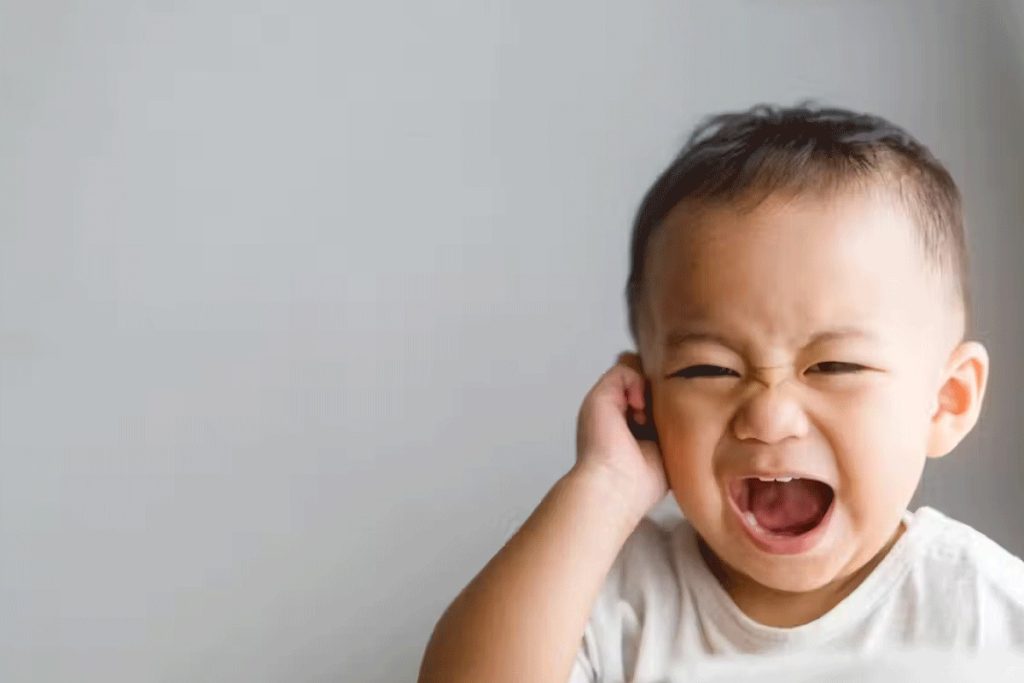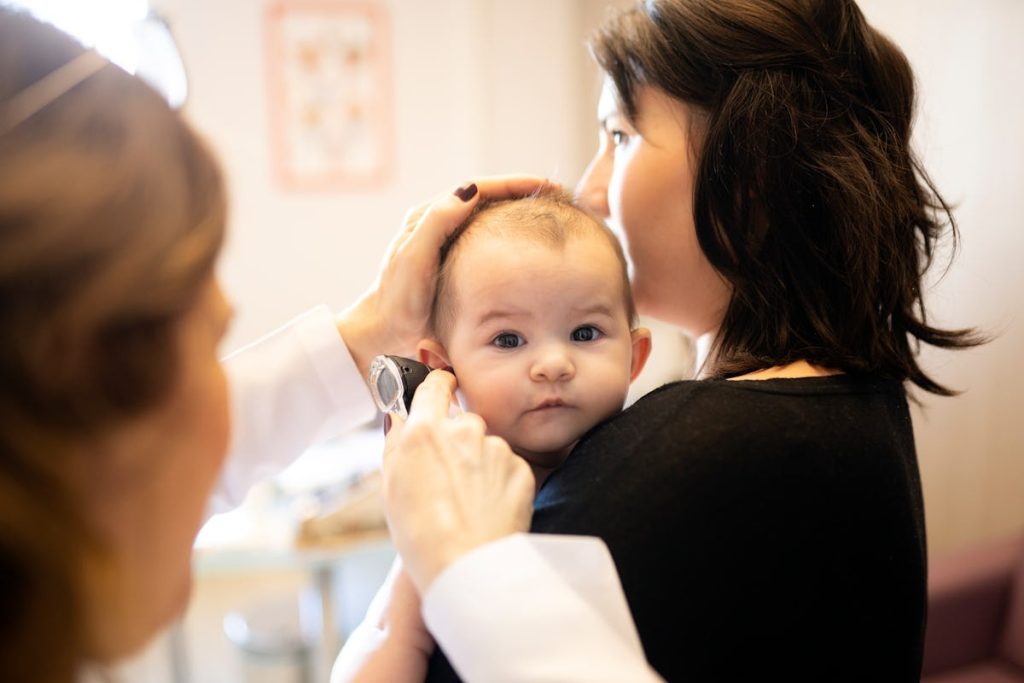
Signs of ear infection in baby can be worrying for any parent. Seeing your baby with a red ear can be scary, but redness alone doesn’t always mean there’s an infection. Sometimes, irritation, rubbing, or overheating can also cause redness.
The NHS and research show that red ears without other symptoms usually aren’t due to infection. However, if the redness and pain continue, it’s best to see a doctor. In this guide, we’ll look at the main signs of an ear infection in babies ” helping you know when to seek medical care.
Not every red ear in babies is from an infection. Other things like irritation, rubbing, or heat can also cause it. Knowing these can help you soothe your baby and decide if a doctor visit is needed.
Babies often touch or tug at their ears. This can be soothing, like during teething or when they’re trying to sleep. It can make their ears red and warm. Gentle care and avoiding irritation can help.
Heat or big temperature changes can also make a baby’s ears red. Being outside on a warm day or near a heating vent can do this. Dressing your baby right can help prevent this.

Allergic reactions can make a baby’s ears red and uncomfortable. This could be from new products, laundry detergent, or other things in the environment. If you think it’s an allergy, find and avoid the cause.
Skin issues like eczema can make ears red, itchy, and uncomfortable. Proper skincare and talking to a doctor can help manage these conditions. This can lessen the redness and discomfort.
Understanding why babies’ ears get red can help parents take better care of them. If the redness doesn’t go away or is with other bad signs, see a doctor.

Ear infections in babies show more than just redness. It’s important to know these signs for quick treatment. Redness is a symptom, but look for other signs too.
Ear pain is a key sign of an ear infection. Babies might get irritable, tug at their ear, or have trouble sleeping. Ear pain can really upset babies, so it’s key to act fast.
A fever often comes with ear infections. If your baby’s temperature is over 100.4 °F (38 °C), it might mean an infection. Keep an eye on your baby’s temperature if they seem upset.
Fluid from the ear is a big sign of infection. This fluid can be yellow or white and smell bad. See a doctor right away if you see unusual discharge.
Ear infections can make it hard for babies to sleep or lie flat. If your baby has trouble sleeping or seems uncomfortable lying down, it might be an ear infection. Try changing their sleep position or using a humidifier to help.
Knowing these signs can help spot ear infections early. If you think your baby has an ear infection, see a doctor for the right diagnosis and treatment.
Ear infections can be divided into two main types: outer ear infections and middle ear infections. Each type needs a different treatment approach. We will dive into these types to help you understand your child’s condition better.
Outer ear infections, also known as otitis externa or swimmer’s ear, happen when bacteria or fungi infect the ear canal. They are often caused by water exposure, irritation, or trauma to the ear canal. Outer ear infections cause redness and swelling in the ear canal and affect up to 10% of people at some point. Symptoms include itching, pain, and discharge from the ear.
Middle ear infections, or otitis media, are more common in children. They happen when bacteria or viruses infect the middle ear, often as a cold or flu complication. This type of infection can cause fluid buildup behind the eardrum, leading to pain and hearing difficulties. Middle ear infections are a big concern in pediatric care because of their prevalence and impact on hearing and development.
Middle ear infections (otitis media) are very common in young children. Statistics show that 80-90% of children have at least one ear infection by the age of 3. This high rate is due to the child’s ear anatomy and developing immune system. Knowing these statistics helps parents and caregivers watch for ear infection signs in children.
By understanding ear infection types and their prevalence, parents can spot signs early. Seeking medical care quickly is key to managing ear infections and preventing complications.
Seeing redness in a baby’s ear can be scary. But there are signs to tell if it’s just a minor issue or an ear infection. It’s important to look at several things to decide if you should see a doctor.
How long the redness lasts is a key factor. If it keeps getting worse, it might be an infection. Harmless redness usually goes away in a few hours. But if it lasts longer and comes with other symptoms, it could be an infection.
To know if redness means an infection, check for other symptoms. Look for:
If your baby has these symptoms with redness, it’s likely an infection. You should see a doctor.
Also, think about if one or both ears are red. If both ears are red and your baby seems fine, it might not be an infection. But, if one ear is much redder or swollen, it could be an infection.
Watch how your baby reacts to simple comfort steps. If redness is just from irritation, a warm compress or pain relief might help. But, if redness doesn’t go away or your baby seems upset, it might be an infection.
A Pediatrician highlights, “If the ear canal is very swollen and red, it might be swimmer’s ear or otitis externa.” Knowing these differences helps you decide when to get medical help for your baby.
As a parent, knowing when to seek medical help for your baby’s ear issues is key. Ear infections can get worse fast. Spotting the warning signs early can prevent serious problems.
If your baby’s ear pain doesn’t go away, it’s time to see a doctor. This could mean a serious infection.
A high fever often means an infection. If your baby’s fever hits 102.2 °F (39 °C), call your pediatrician. They’ll check for an ear infection or other serious issues.
Seeing discharge from your baby’s ear that’s bloody or smells bad is a big warning sign. It might mean a ruptured eardrum or a severe infection. You need to see a doctor right away.
If your baby under 6 months shows signs of an ear infection, like being fussy or feverish, see your doctor fast. Young babies are more at risk for serious problems.
For serious or ongoing ear infections, your pediatrician might give antibiotics. It’s important to follow their advice to make sure your baby gets the right treatment.
“Prompt medical evaluation is key for babies with severe ear infection symptoms to avoid long-term issues.”-Experts emphasize.
Watching for these warning signs and acting quickly can greatly help your baby’s recovery and health.
A red ear in babies can be due to many reasons, not just infections. It’s important to know the signs of ear infections, like ear pain, fever, and fluid. This knowledge helps in caring for your baby the best way.
To lower ear infection risks, take preventive steps. Clear your baby’s nose, avoid secondhand smoke, and keep vaccinations up to date. Gregory K. Milani, MD, suggests this. Also, breastfeeding can help prevent ear infections.
Being aware of ear infection symptoms in toddlers is key. Taking early action can keep your baby healthy and happy. If you’re worried about your baby’s ear health, talk to a doctor for advice.
Signs of an ear infection in babies include ear pain, fever, and fluid from the ear. They might also have trouble sleeping or lying down. If your baby shows these signs, you should see a doctor.
A red ear doesn’t always mean an infection. It could be from irritation, rubbing, or heat. But, if it’s red, hurts, or has discharge, it might be an infection.
Look at how long the symptoms last and if they’re with other signs. Check if one or both ears are affected. If there’s fever, pain, or discharge, it’s likely an infection.
There are outer and middle ear infections. Outer ear infections happen when the ear canal gets infected. Middle ear infections are more common and often come from colds or flu.
See a doctor right away if your baby has severe pain, high fever, or discharge. This is true for babies under 6 months. Knowing these signs can help your baby get the right treatment.
Keep your baby’s environment clean, avoid smoke, and make sure they get all their shots. These steps can help prevent ear infections.
Toddlers with ear infections might have ear pain, fever, and fluid from the ear. They might also have trouble sleeping or lying down. If your toddler shows these signs, see a doctor.
Look for signs like ear pain, fever, and fluid from the ear. If your infant has trouble sleeping or lying down, it could be an infection. Always check with a doctor if you’re not sure.
Subscribe to our e-newsletter to stay informed about the latest innovations in the world of health and exclusive offers!
WhatsApp us